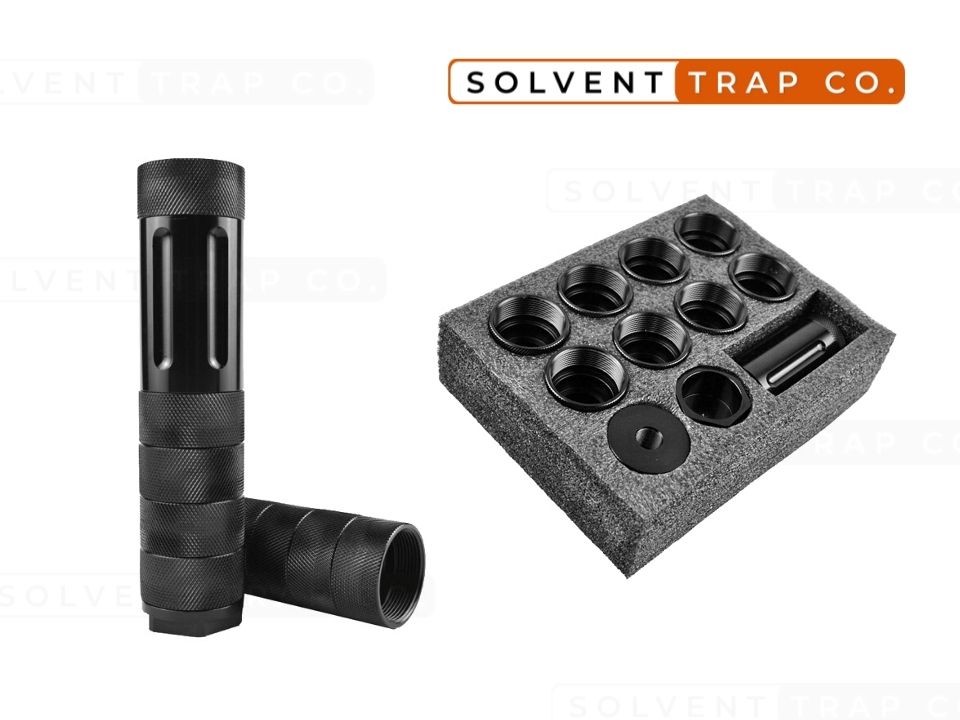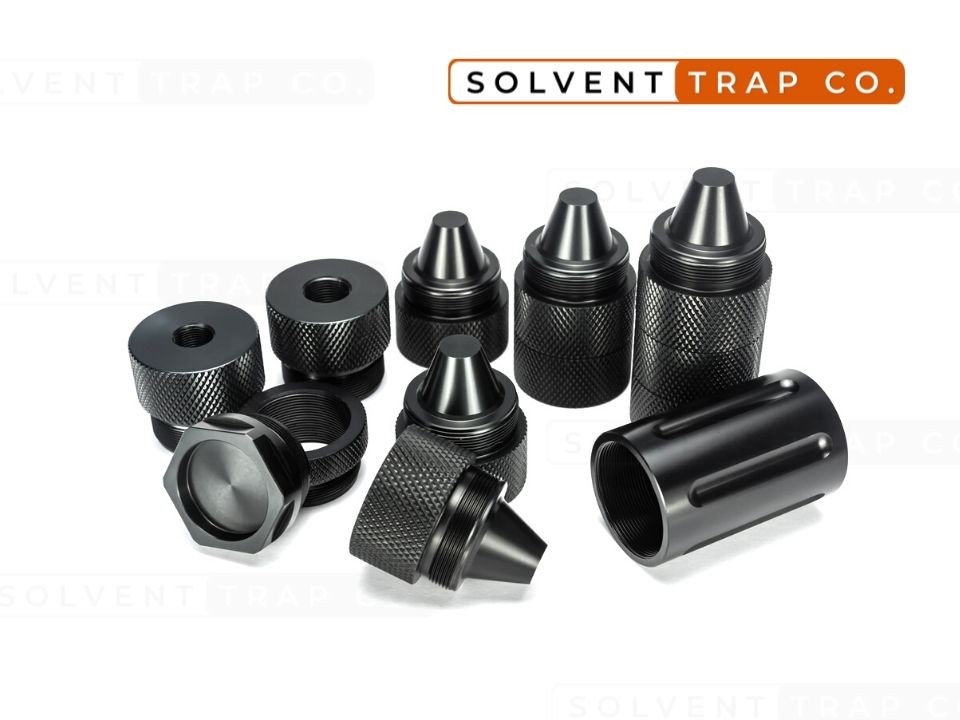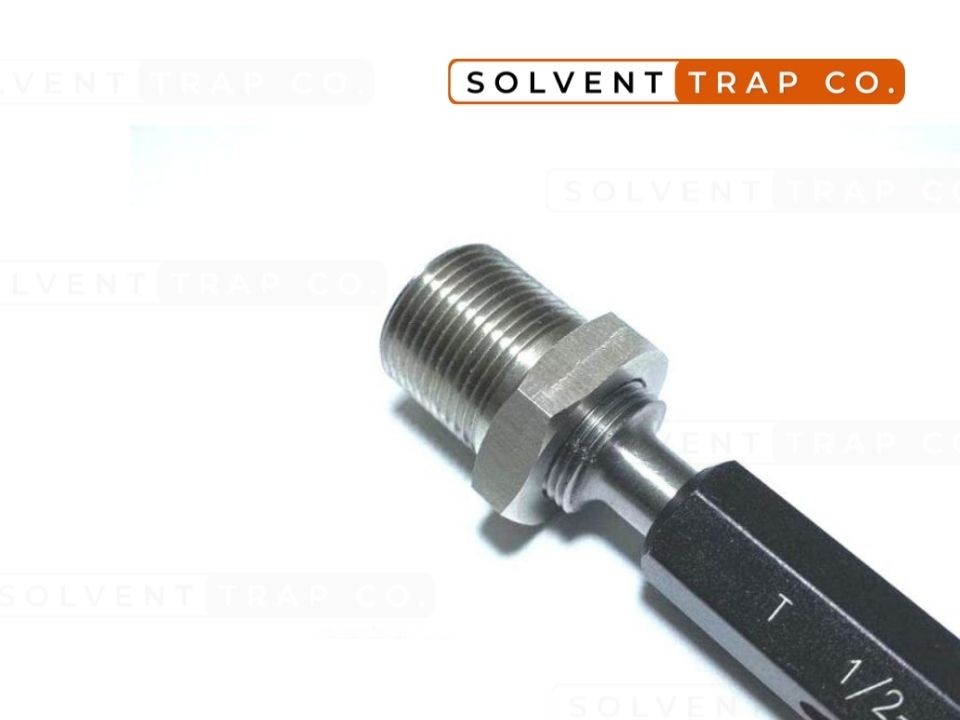Solvent Traps are Not Suppressors: Why This Remains True in 2022
[vc_row][vc_column][vc_column_text]The importance of a solvent trap to a gun owner cannot be overemphasized. Akin to a hunter needing a dog during hunting trips, gun owner’s of every capacity NEED a solvent trap during firearm cleaning operations…Sure, one can hunt without the help of a dog for retrieval, flushing and pointing — but once a dog is used, the benefits realized make it nonsensical to go back to hunting without “mans best friend” by your side. Similarly, one can clean their firearms without a solvent trap cleaning system, but “Once you go Trap, you never go back” because just like with our example above, the benefits justify the costs and then some!
Don’t simply take our word for it; if you are cleaning your firearms without a solvent trap, try one out and we can almost guarantee that you will never revert back to your traditional methods.
Solvent traps have been in existence for decades. Although †heir design may have been crude initially, being developed from standard household and automotive parts, they served their intended purpose of trapping fluids during cleaning sessions.
Over the years, the design of solvent traps has evolved, and modern-day solvent traps now have aesthetic design similarities to suppressors – but they are not same. Just because something “looks like” something else means nothing, it’s all about intended purpose and functionality! The ATF has facilitated a legal way of manufacturing and registering your own firearms and class 3 firearm parts through the Form 1 process, which they proceeded to improve the speed and efficiency of the application process by allowing electronic application submissions through their Eforms process. With the Form 1 application available, many individuals have tried to modify their solvent traps into suppressors. But not just solvent traps, anything that’s tubular, whether it be automotive parts, Maglites, or even custom piping from a hardware store – Many others have altered these same household items to be used as solvent traps too!
With that being said, there has been a lot of completely false propaganda permeating social media, message boards and other mediums relating to the legality of solvent traps. Much of this confusion stems from ATF seizures and company shutdowns over the past several years of solvent trap companies. Many companies that have been shut down were selling solvent traps as Form 1 Kits, which according to current NFA/ATF rules, laws and previous public statements is still not illegal. As a ATF has publicly defined solvent traps as nothing more than a firearm accessory if it’s truly a solvent trap. They have made their position clear, which is also backed by limited information that can be sourced from the NFA Handbook and Gun Control Act of 1968 that solvent traps can be purchased legally without a Form 1 on the condition that you do not modify, alter or redesign the device for silencing, muffling or for diminishing the report of a firearm without first filing & receiving back an approved Form 1 Tax Stamp from the BATFE.
So, not only did the ATF create the Form 1 Application Process allowing individuals who are able to pass the application background check and pay the $200 NFA Tax Stamp, but they made the process more appealing and faster through layering the Eforms options that reduces the processing/approval time down by as much as 90%. Therefore, there’s a clear legal channel to convert any item into a suppressor as long as the approval is received prior to the development or conversion of the item that is intended to be serialized. Obviously, if someone has applied through the Form 1 Process and has received their approved serial number and Tax Stamp, they are going to need something to convert and serialize. This is why there are many Form 1 Kit companies…
The ATF facilitated the demand which incentivized Form 1 Kit companies to enter the market – These companies essentially sell solvent traps as Form 1 Kits with an intent on being converted legally. Sure, there may be some that don’t properly disclaim the legal Tax Stamp channel one must follow to remain legal and there may be others who marketed their products in a way to circumvent rules and regulations, but the ATF began going after and shutting down companies selling Form 1 Kits that followed the definitions mentioned above. This obviously makes no sense if the kit does not allow for a projectile to pass through the center and without modification one is not able to use the unit to muffle, reduce or silence a firearm.
If there were no laws being broken how did the ATF shut these companies down? Mainly, they looked at their express or published intent through the context of information on the Form 1 Kit web sites along with metadata of keywords these companies were marketing. One of the main tools the ATF used though is proving “constructive intent”, which basically means that even though without modification the Form 1 Kits were not “Unregistered Class 3 Devices”, certain characteristics of the devices would cause them to be considered “Unregistered NFA Items”. The ATF would purchase the items undercover and prove there were signs of constructive intent and use this information to get warrants to shut the companies down. One of the most notable examples are kits that have center markings or dimples on the internals or end caps, which in the eyes of the regulators a center mark or dimple is essentially a completely drilled hole.
No pun intended, but a keen observer would notice many “holes” in the logic above. The contradictory fact that the ATF created and improved a process allowing a person to legally convert any item into an NFA Item such as a suppressor as long as the item remains unmodified and doesn’t allow a bullet to travel through the center and silence a firearm, until the approved Tax Stamp is received by the applicant, but then goes after companies selling unmodified kits to meet the demand the ATF facilitate is beyond our understanding.
The confusion on whether Form 1 Kits are legal due to ATF actions that seem to go against published or known laws and NFA definitions spilled over to legal solvent trap companies. Confusion causes many to not purchase legal solvent traps for cleaning, which is the original intended purpose that many companies, such as SolventTrap.co sell them for.
The good thing though is law is law and even though there is a lot of confusion created by false propaganda, we at SolventTrap.Co will do our best to demystify it and will continue operations in our legal business with absolutely no plans on stopping!
Just because a solvent trap resembles something else, does not mean it is nor is intended to be used as the very thing it resembles. A mock suppressor or “barrel shroud” may resemble a suppressor, but these are simply for aesthetics. Some mock suppressors have been converted in the past and caused individuals legal issues, but they were never intended to be converted, so it’s the buyers responsibility to know what the deal is to a very large degree!
But before we go any further, let’s give you a rundown of solvent traps and why they should not be confused with suppressors.[/vc_column_text][/vc_column][/vc_row][vc_row][vc_column][vc_custom_heading text=”Solvent Trap – Firearm Cleaning Accessory” use_theme_fonts=”yes”][vc_column_text]A Solvent Trap is a device attached to the threaded barrel of a gun to capture cleaning solvent during cleaning operations. They typically have a threaded muzzle attached to the threaded barrel of a gun.
During cleaning operations, the intricate design of storage cups in a solvent trap captures dirt from the gun while allowing the solvent to flow through a hole till it gets to the cup at the bottom. The end of the solvent trap is capped to ensure that any of the chemicals won’t leak all over while cleaning. This feature allows gun owners to clean their guns without creating a total mess in the process.
Because the cleaning solvent is expensive, the solvent traps also allow the liquid to be reused after cleaning. They filter the dirt and subsequently allow the dirt-free fluid to pass through to a cup where it is trapped and stored.
Important distinction of solvent traps is best exemplified with the following quote referencing information from the Gun Control Act of 1968 and the NFA Handbook of the current year.
—
“The stated intent of a solvent trap is to catch and trap gun cleaning solvent during bore cleaning sessions or operations, commonly performed on firearms. Solvent traps do attach to the muzzle of a firearm but do not have any design features intended to allow a bullet to pass through them.
Since as originally manufactured they are not intended to silence, muffle or diminish the report of a portable firearm they are not silencers as defined in 18 U.S.C. 921(a)(24) and thus also are not firearms as defined in 18 U.S.C. 921(a)(3) or 26 U.S.C. 5845(a)(7).
However, if the solvent trapped was redesigned or utilized to assemble a device for silencing, muffling or diminishing the report of a portable firearm or if intent was demonstrated to use the device for silencing, muffling or diminishing the report of a portable firearm, the solvent trap would be classified as a “firearm silencer” as defined in 18 U.S.C. § 921(a)(24) and as a “firearm” as defined in 18 U.S.C. § 921(a)(3)(C) and 26 U.S.C. § 5845(a)(7).”
—
For a figurative comparison, it is not even a matter of “apples” and “oranges”, suppressors are bananas and solvent traps aren’t even a fruit.
The quote above is very important as there is a lot of fear in the market relating to whether solvent traps are legal or not, this is precisely why going with a company such as SolventTrap.Co will alleviate any confusion – If you purchase from SolventTrap.Co, you know you are getting a Solvent Trap in every legal definition.[/vc_column_text][/vc_column][/vc_row][vc_row][vc_column][vc_custom_heading text=”A Basic Rundown of Suppressors” use_theme_fonts=”yes”][vc_column_text]A Suppressor is a muzzle device that reduces the gunshot sound when a firearm is discharged. The suppressor does this by slowing the discharge of the propellant gas that accompanies the bullet when it’s fired.
This feature is accomplished by a series of designed baffles inside the suppressor. The baffles trap the propellant gas as they leave with the bullet and convert the accompanying sound energy into heat trapped within the chamber.
Though a suppressor is effective when used with the right gun, the sound of the gunshot is not eliminated but instead reduced to a phut sound. The beauty of a suppressor is that it dampens the recoil, eliminates muzzle flashes, and reduces the chances of hearing loss from gunshots to a bare minimum.[/vc_column_text][/vc_column][/vc_row][vc_row][vc_column][vc_custom_heading text=”Similarities and Differences between a Solvent Trap and a Suppressor” use_theme_fonts=”yes”][vc_column_text]Now that we have explained what solvent traps and suppressors are, let us take a look at some of their similarities:[/vc_column_text][porto_info_list icon_color=”#da4a00″][porto_info_list_item]
Similarities
- They both have a threaded end for attachment
- They have an intricate design of baffles
- They have end cups and a similar mechanical design
Though solvent traps and suppressors have a lot in common, they also have several differences, which clearly differentiates them from each other.[/porto_info_list_item][porto_info_list_item]
Differences
- Suppressors have an exit hole for bullets to pass through, while solvent traps don’t
- Suppressors are designed to withstand the pressure and explosion that accompanies a projectile, while solvent traps are designed to resist corrosion from cleaning agents.
- Suppressors are manufactured to reduce the sound and muzzle flash from gunshots, while solvent traps are made for the sole purpose of trapping cleaning solvent during gun cleaning.
- Suppressors can allow bullets to safely pass through them without the risk of a blowback explosion due to a slight change in trajectory. In contrast, solvent traps possess a high risk of blowback explosions when modified incorrectly as a suppressor.
[/porto_info_list_item][/porto_info_list][/vc_column][/vc_row][vc_row][vc_column][vc_custom_heading text=”Legalities of Solvent Traps” use_theme_fonts=”yes”][vc_column_text]Purchasing a solvent trap is totally legal in the US. However, the ATF draws a line when individuals attempt to modify or alter the solvent trap for other purposes. For instance, solvent traps are quite similar to suppressors and can easily be converted into a suppressor with a few modifications.
Doing this without legally filing and receiving back a form 1 from the ATF can attract a felony charge. The ATF mandates that any alterations to a Solvent trap should be registered and filed using the ATF Form 1. Submission of the ATF Form 1 is accompanied by a compulsory stamp charge of $200.
After Form 1 has been received, the gun owner is required to engrave the serial number on Form 1 onto the solvent trap for identification purposes before any alterations are carried out on the device.
Now, this might come as a surprise to you, but all factory-made suppressors come with a similar engraved serial number used for identification purposes in the event of a crime or a shootout.
So depending on the state you reside in, purchasing a suppressor or converting a solvent trap into one is considered a crime and attracts a felony charge.[/vc_column_text][/vc_column][/vc_row][vc_row][vc_column][vc_custom_heading text=”What to expect in 2022″ use_theme_fonts=”yes”][vc_column_text]As of the time of writing this piece, the ATF stance on the sale of solvent traps is that “Solvent Traps are legal.” Nevertheless, any intent to use the device as a suppressor without proper registration will bring the full weight of the law to your doorstep.
Several states, including New York and California, have moved forward to prohibit suppressors or their conversion from solvent traps. So it would be advisable to check with your state laws come 2022 to know the current stance of gun laws in your location.[/vc_column_text][/vc_column][/vc_row][vc_row][vc_column][vc_custom_heading text=”Bottom line” use_theme_fonts=”yes”][vc_column_text]Manufacturers design and formulate a product for a particular use. Making any alterations to the product can cause damage, severe liability, or even felony charges to the owner, especially when the modified product is questionable in the eyes of the law.
That being said, solvent traps are made solely for trapping solvents when cleaning firearms. The product should not be modified for any other purpose, as doing such can cause serious liability to the owner, including felony charges.
We offer a variety of solvent traps suitable for different pistols and rifles, as well as other firearm cleaning products that can help improve the efficiency and longevity of your firearm. Buy your quality Solvent Traps from us today![/vc_column_text][/vc_column][/vc_row][vc_row][vc_column][vc_column_text]Solventtrap.co is focused on developing safe and environmentally friendly cleaning solutions. We specialize in Solvent Traps & other cleaning technologies for firearm maintenance. This content is not legal advice. It is intended for educational purposes only. Legal advice may only be provided by a properly licensed attorney. We recommend you consult a lawyer.
References:
https://www.silencershop.com/blog/post/what-is-a-solvent-trap
https://shootersden2.com/post/2019/02/10/how-do-solvent-traps-work[/vc_column_text][/vc_column][/vc_row]





Leave a Reply